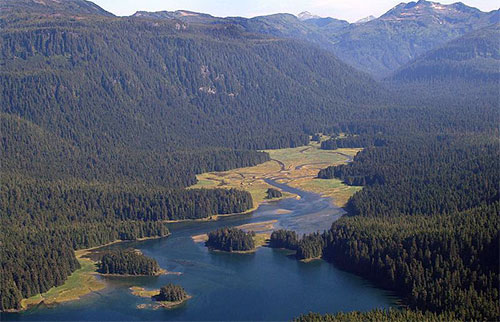
Nation's Top Scientists Urge Obama Administration to Stop Old-Growth Logging and Save the Tongass Rainforest
January 20, 2015
USDA Secretary Tom Vilsack announced in July 2013 that a transition out of old-growth logging and into logging of second growth – forests originally logged in the 1950s that have reforested and can replace old-growth logging – would commence over time. The Forest Service is currently amending the Tongass National Forest Land Management Plan of 2008 with a draft due this August. According to the Geos Institute based in Ashland, Oregon, the Forest Service continues to put forward controversial old-growth logging sales at levels not seen since the early 1990s, claiming a need to log old-growth for another 10-15 years despite independent analyses that show second growth will soon be available to replace old growth timber.
Chaik Bay in SE Alaska (John Schoen) More than 200 distinguished scientists, including Pulitzer Prize winners, were joined later by climate scientists and the American Fisheries Society, American Ornithologists’ Union, American Society of Mammalogists, Ecological Society of America, Pacific Seabird Group, Society for Conservation Biology and The Wildlife Society in calling for an end to old-growth logging on the Tongass, the only national forest that still clear-cuts its old growth. According to Dominick A. DellaSala, Chief Scientist of Geos Institute, “unprecedented scientific support for Tongass rainforest protections is a signal to President Obama that there is no time to waste in ending old growth logging on his watch, which would be a defining moment for the President’s climate and environmental legacies.” The three scientists' letters each recognize the Tongass’ irreplaceable ecosystem benefits as:
“Protecting old-growth forest habitat on the Tongass is the key to maintaining the productivity and resilience of extraordinary fish and wildlife populations that have otherwise declined throughout their southern ranges in North America,” said Grant Hilderbrand, President of the Alaska Chapter of The Wildlife Society. The Tongass is a national repository for atmospheric carbon absorbed by its large trees, productive soils, and dense rainforests that store at least ten times more carbon than any other national forest. When rainforests are cut down, most of the stored carbon is released as carbon dioxide pollution, a greenhouse gas. President Obama has made climate change his signature environmental agenda; however, his administration has yet to link forest protections with climate security. “We are calling on President Obama to keep carbon in the trees, much like we need to keep coal in the ground - both are essential to slowing runaway climate change in Alaska and throughout the world for future generations,” said Doug Parsons, North America Policy Director for the Society for Conservation Biology. According to Alaska Department of Environmental Conservation's 2010 final report submitted by the adaptation advisory group to the Alaska Climate Change Sub-Cabinet, Alaska has been hardest hit by accelerating climate change that includes sharp reductions in snow-cover, shorter river- and lake-ice seasons, melting glaciers, sea-ice and permafrost retreat, increased depth of summer thaw, die-back of Alaska yellow cedar and displacement of aboriginal villages from traditional lands. “Quickly transitioning the Tongass rainforest out of clear-cutting irreplaceable old-growth forests would bring certainty to the timber industry and legacy rainforest benefits to the American people,” added DellaSala. DellaSala said in an email to SitNews he will be attending the fifth meeting of the Tongass Advisory Committee held this week in Juneau from January 20–23.
Edited by Mary Kauffman, SitNews
On the Web: For copies of the scientists' letters click here:
Source of News:
|
||
